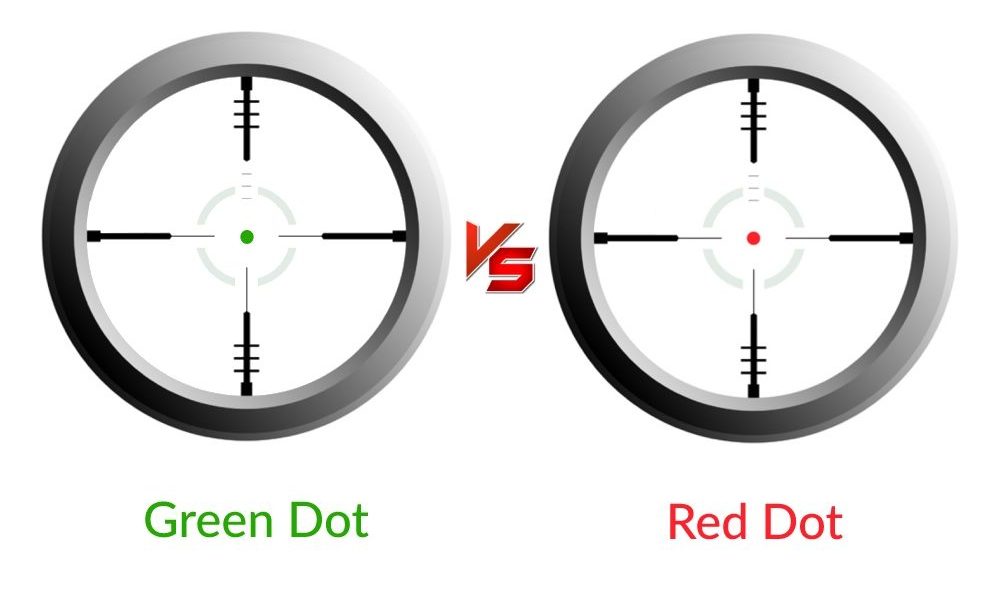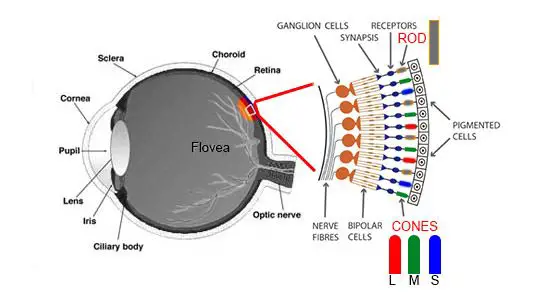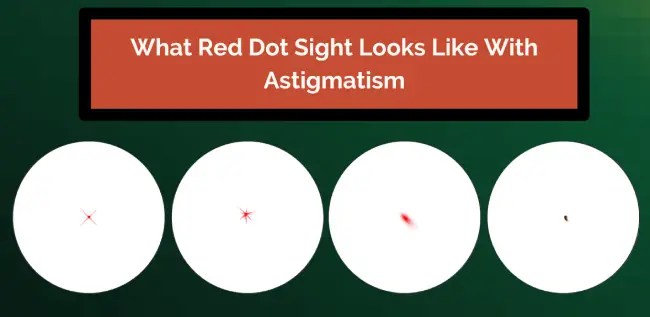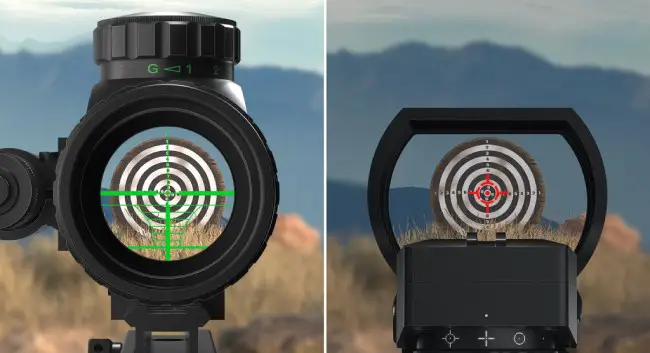The “Green Dot vs Red Dot” debate isn’t something new. You’ll find much information online about how red and green dot sights provide different facilities, but it’ll get confusing quickly. Well, not anymore.
This guide will provide a more logical approach to solving the equation once and for all.
We’ll explore how human eyes prefer one over the other and provide you with the necessary guidance to make an informed decision. Let’s get started.
Green Dot vs Red Dot: What’s The Actual Difference?

It’s a fact that the green dot suits those with Astigmatism best. Other than that, there’s no significant difference between the two as long as sufficient battery life, and light intensity are available in your shooting area.
People usually pick a sight that they have grown up with. We’ve gone through the opinions of many US gun users, and here’s a round-up of our findings:
- Some think green works better in the daytime, while red in low-light conditions.
- Most prefer green because human eyes naturally mark green faster than red.
- Since most prefer a color that they’re used to, they’re usually not interested in trying a different color simply because their eyes will find the new color somewhat odd.
- Battery life is a concern here (not a major one, though). Red dots are known to use less battery, i.e., as much as three times less when compared to green dot sights.
- Some even follow this simple rule – red for outdoors, green for indoors! You can also try green in areas with no green around you, such as deserts.
In fact, there hasn’t been any study to prove that one works better than the other.
However, contrast matters sometimes. The world around us is mainly made up of green, blue, brown, and grey. Since you’re more likely to shoot in a green background rather than a red one, red will be a wise choice as there will be a lesser chance of washing out.
Based on these findings, it would be best to try both and see which one seems best for you: red dot or green dot!
The Reason Our Eyes Perceive Green Better Than Red
The key difference between green and red dots has to do with how we perceive colors. Let me explain the whole thing in the simplest terms I can think of. Here goes nothing:
You probably know red has the longest wavelength among all the visible light spectrums (colors), ranging between 625nm to 740nm. Red lights are used in traffic signals or commercial ads because red lasers or neon lights can be noticed from far away.
On the other hand, green lights are smaller in wavelength, ranging between 520nm and 565nm.
Despite being of shorter wavelength than red light, we feel comfortable focusing on the green-colored dot, but why is that?
Here’s why and how that happens.
Thanks to natural selection, we’re now at the top of the world’s food chain. Aside from extraordinary thinking and learning capabilities, humans also developed a trichromatic vision over time.
Now, what does that even mean, right?
It means we have 3 different types of light-sensitive cells inside our eyes. Although most mammals are dichromatic, meaning they only have 2 types of cells (cones), our three different types of cones allow us to have a much better view than those other mammals.
Our distinctive cone cells can react to different wavelengths of light. The short ones respond to blue light, the medium to green, and the long ones respond to red lights.
The cones are in charge of detecting the intensity of the color, whereas rods support the low light vision.

The issue is that our short cones can detect up to 560nm, and the medium ones peak at 530nm. The wavelength of red-colored light ranges from 625nm to 740nm, compared to green light (520nm to 565nm).
Now, if you look at that data, you’ll notice that both our short and medium cones respond well to green light.
On the other hand, only long cones process the red light. That’s why green is the color that our brain picks up and processes faster.
As a result, whether you are using one of your reflex sights, or holographic sights, if we look at two (red and green) lights at the same power level, the green will appear brighter!
The red dot is also tricky to focus on if you’re suffering from a refraction error named Astigmatism. With Astigmatism, you’ll have trouble focusing through a red-colored dot as the vision might become blurry.

In General, red-colored lights put more strain on the eye than green ones. That’s why people with Astigmatism tend to do better with green MOA dots.
Green vs Red Dot: When to Choose Which
Now that you know what is the difference between green and red colors, it’s time to decide when you should use each.
If you have a perfectly healthy eye and are in normal light conditions, green dot sights can be used for the vast majority of situations. Red dots will work just fine too unless there is an exceptionally bright background behind your target.
For instance, if you are shooting in a bright environment like in the middle of a desert or snow-covered area, then choosing red could be better as it will appear slightly more visible against the background.
On the other hand, if you suffer from Astigmatism, green dots are a better choice. Also, if you are hunting in a dense forest, red could be better as the background will not have too many bright elements to interfere with your target.
In general, if you don’t suffer from any kind of vision problem and are shooting in normal lighting conditions, go with green dots. Red ones can come in handy when there’s an exceptionally bright background or when you are relying on low light performance.
And that’s about it. This is all the information you’ll need to know to choose your version of the winner for out “Green Dot vs Red Dot” debate. Of course, you are free to choose whichever you like, but most of the time, the green dot will yield better results than the red one or your iron sights.
FAQs
1. Does the US Military Use Red Dot Sights?
Ans. Yes, they do. The US military usually uses the Aimpoint CompM4 Official US Army M68CCO Red Dot sight. In fact, since 1997 Aimpoint has provided over 2 million red dot sights to the US military.
2. Are Red Dot Sights Visible at Night?
Ans. Yes, you can see clearly in low-light conditions and some manufacturers offer a night vision mode on their red dot sights for enhanced brightness.
3. Is a Green Dot Really Better for Astigmatism?
Ans. Not really. In fact, many who have this condition say red dots work better for them. This is because color preference is determined by what your eyes can see easily and not by astigmatism alone.
4. Why Is the Green Dot More Expensive?
Ans: Green dot sights increase your battery life. They are almost 30 times brighter than a red dot sight using the same power. That is the primary reason they can get up to 32 times more expensive.
5. What Distance Is a Red Dot Sight Good For?
Ans: Red dot sights are primarily used in shorter distances. Distances less than 100 yards are perfect for red dot sights. However, you can use high-quality red dots if you want to cover more areas.
6. Is Red Dot vs Green Dot Just a Personal Preference?
Ans: Technically, no. If you have Astigmatism, a red dot will limit your visibility. Whether you choose green or red dot depends on how you plan to use your sights and what kind of environment you are shooting in.








Leave a Comment